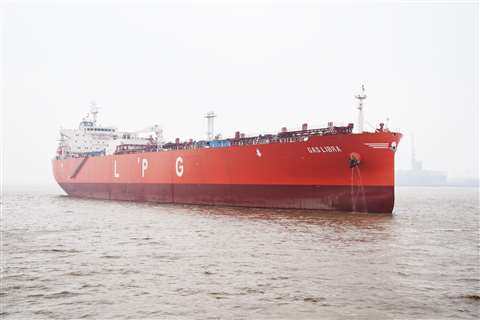Carriers getting dual-fuel retrofits
07 February 2023
Order follows two earlier retrofits
The MAN B&W 6G60ME-C engines aboard liquefied natural gas (LNG) carriers Gas Libra and Gas Scorpio will be retrofitted to dual-fuel MAN B&W 6G60ME-LGIP units capable of running on LPG.
The ships are scheduled to enter drydock in January 2024.
COSCO Shipping Heavy Industry (Guangdong) yard said the two LPG carriers are from the fleet of Tianjin Southwest Maritime Ltd., the Chinese liquefied-gas carrier operator. COSCO is exercising the option in a contract signed with MAN Energy Solutions’ after-sales division, MAN PrimeServ, in October 2022 to similarly retrofit two LPG carriers to dual-fuel operation.
 Tianjin Southwest picks up option for LPG carrier dual-fuel retrofits. Further two vessels bound for conversion in collaboration between MAN PrimeServ and CMS. (Image: MAN)
Tianjin Southwest picks up option for LPG carrier dual-fuel retrofits. Further two vessels bound for conversion in collaboration between MAN PrimeServ and CMS. (Image: MAN)
As with the previous two vessels, MAN PrimeServ will jointly carry out the work with CMS (CSSC Marine Service Co. Ltd.), the after-sales subsidiary of CSSC Marine Power Group.
“It’s crucial to nurture partnerships to successfully pull off dual-fuel retrofit projects and we are very happy to collaborate with CMS on these – now – four vessel retrofits,” said Per Rud, senior vice president, MAN PrimeServ. “Significantly, this will be our first time working with a licensee’s own after-sales division; the after-sales market should know that MAN PrimeServ is open to working with partners in order to support shipowners globally. Our negotiations with CMS have concluded to our mutual satisfaction and will strengthen our partnership.”
The taking up of the original contract’s option also follows Oslo-listed BW LPG announcement in June 2022 that it, under MAN PrimeServ’s supervision, had converted the main engine of the BW Malacca to dual-fuel running. The last such conversion for a series of 15 LPG carriers, all work was carried out at Yiu Lian Dockyards in Shenzhen, evidence of China’s ability to successfully execute such retrofits.
Klaus Rasmussen, head of Projects and PVU Sales, MAN PrimeServ, said switching to low-carbon fuel is the most effective way to decarbonize the existing maritime fleet.
“In this respect, dual-fuel retrofits are an excellent device for shipowners to maintain their assets’ value moving forward,” Rasmussen said. “Additionally, for Very Large Gas Carriers, their ability to operate off their own cargo makes for a very positive business case. Before the original signing of this contract, Tianjin Southwest had already ordered six vessels powered by ME-LGIP main engines and LPG is quickly becoming the de facto standard in this segment. Currently, we estimate that there are over 150 VLGCs with single-fuel engine technology that could benefit from conversion to LPG-running.”
According to MAN, LPG is a better option than compliant fuel-oil with high lifetime-savings prospects. By leveraging LPG as a marine fuel, vessels benefit from savings due to lower fuel consumption and full dual-fuel flexibility, which guards against price sensitivity to post-2020 fuel-price fluctuations. Furthermore, the ability to use LPG cargo as a supplemental fuel source also reduces time and fees for fuel bunkering.
Harnessing LPG propulsion also translates into cleaner, more efficient engines that are cheaper to maintain. In addition, the fuel flexibility of dual-fuel engines ensures full redundancy for uninterrupted operations, the company said.
Compared to 2020-compliant fuels, using LPG as a fuel would reduce: SOx by 99%, CO2 by 15%, NOx by 10%, and particulate matter by 90%.
POWER SOURCING GUIDE
The trusted reference and buyer’s guide for 83 years
The original “desktop search engine,” guiding nearly 10,000 users in more than 90 countries it is the primary reference for specifications and details on all the components that go into engine systems.
Visit Now
STAY CONNECTED




Receive the information you need when you need it through our world-leading magazines, newsletters and daily briefings.
CONNECT WITH THE TEAM













